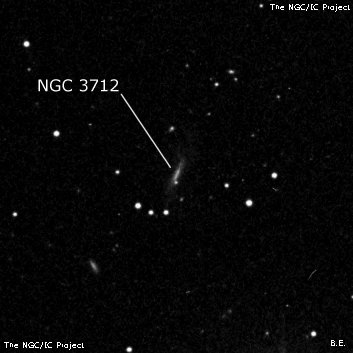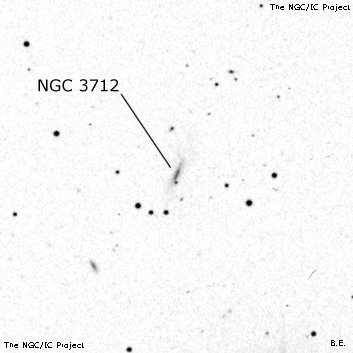NGC/IC Project Restoration Effort
(This is a very very beta version)
NGC3712


Basic Information
Location and Magnitude
Right Ascension: 11:31:53.6
Declination: +28:21:31
Constellation: UMA
Visual Magnitude: 13.3
Historic Information
Discoverer: Herschel J.
Year of discovery: 1827
Discovery aperture: 18.3
Observational
Summary description: f, vS, R, smbM
Sub-type: Sa
Corwin's Notes
=====
NGC 3712 is probably NGC 3714. JH observed the objects during different
sweeps, and his position for N3712 is enough off his others to lead him to
think he'd found a new nebula. There is nothing at his position, though, and
the descriptions of his two different nebulae are very similar.
There are, however, some curiosities here. JH was looking for two of his
father's nebulae, II 367 (N3713) and III 353 (probably N3714), in the area.
JH assigned the numbers to two of his own nebulae (h906 = N3713, and h907 =
N3714), but in his description of N3713 (never seen on the same nights as
N3714), he says "No companion seen." Similarly, in his description of N3714,
he claims, "No other near on the same parallel." The two galaxies are only
12.6 arcmin apart. How does it happen that neither appeared in the same sweep
with the other -- aside from Sweep 68 where JH gives a crude declination and
no RA to h905 = N3712 -- though he went over the area in 8 different sweeps?
JH also noted the 10 minute error in his father's position for III 353. The
galaxy, however, is neither at WH's "wrong" position, nor at the "corrected"
one. (I thought I had found it just 10 seconds of time off the "wrong" one,
but I, too, made an error in RA, this one of 1 hour. Is it possible that WH
also made a 1 hour error? Nope -- in that case, the object would have
appeared preceding 44 LMi, not following it, and would have been the first
object referred to that star that night, not the last.) JH had to stretch a
bit to make III 353 fit his position, but he managed it in the note in GC,
saying that WH's position (first corrected by CH), when corrected, falls
within 35 seconds of his (JH's) own.
Finally, N3714 is a rather peculiar galaxy, having a faint, disturbed corona
with a broad plume to the southwest. I am unable to decide if two objects --
one superposed on the galaxy just to the northeast of the center, the second
32 arcseconds to the southwest -- are stars or compact companion galaxies. I
am guessing here: the superposed object is a compact galaxy, the more distant
object is a star. Based on their appearances in the SDSS image, both are
stars -- but the distortion of the big spiral is even more noticeable.
Spectra are clearly needed.
Steve's Notes
=====
NGC 3712
18" (3/17/07): UGC 6506, the galaxy identified as NGC 3712 in the RNGC and PGC, appeared extremely faint, small, elongated. Occasionally it was glimpsed as a very low surface brightness hazy patch with no concentration. It extended perhaps 0.4'x0.2' in the direction of a couple of stars with a third star nearby making a triple. Located ~8' NE of mag 6.7 HD 100041.
More likely NGC 3712 is a duplicate observation of NGC 3714. See observing notes for that number.



